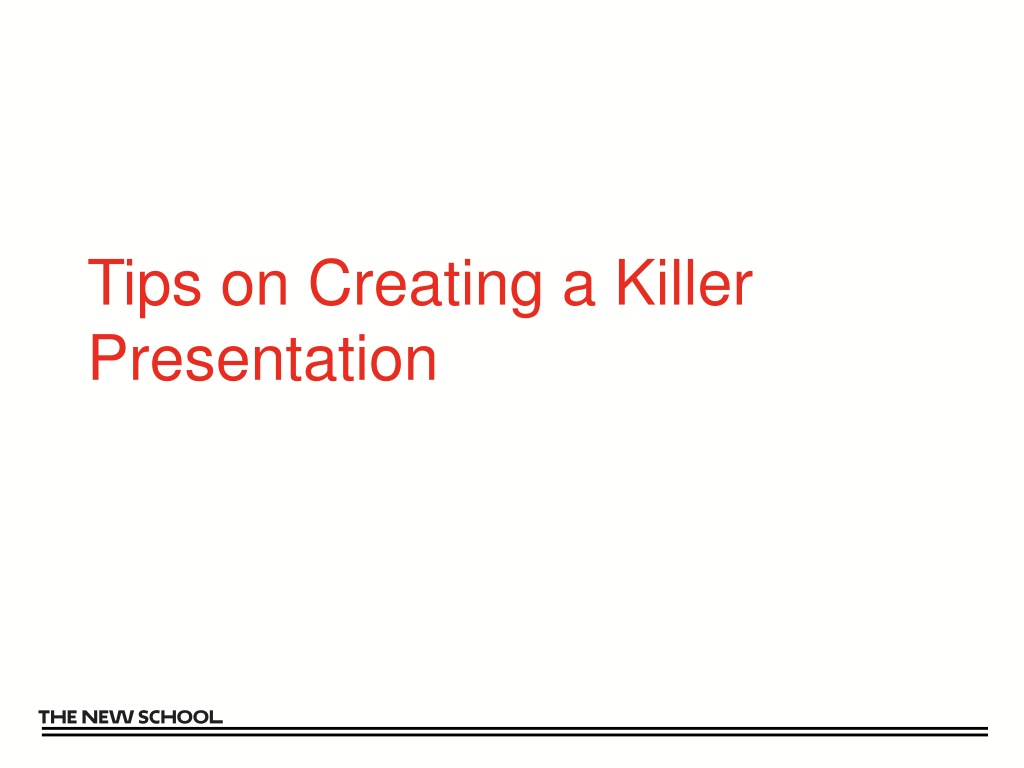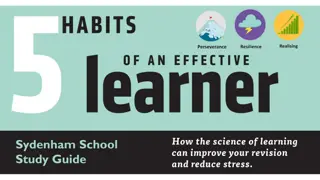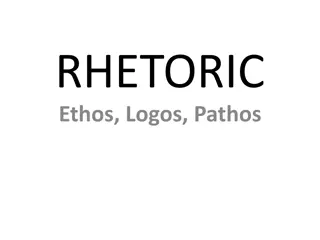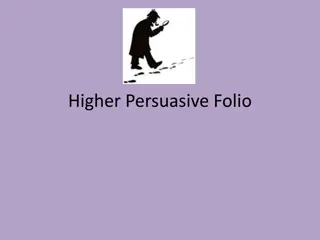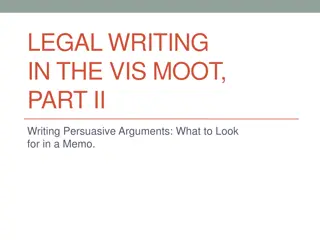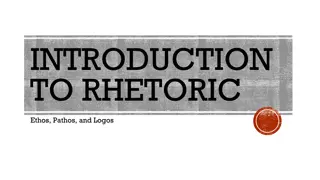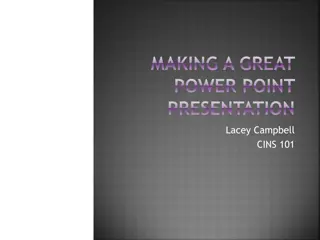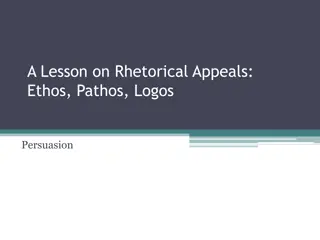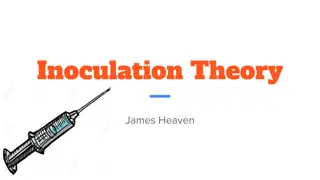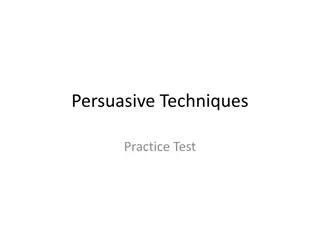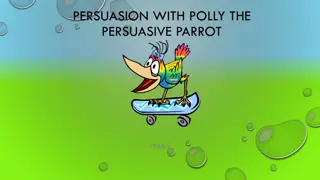Mastering the Art of Persuasive Presentations
Learn the essential steps to crafting a compelling presentation that captivates your audience. From establishing credibility to connecting emotionally and providing evidence, follow a structured approach to deliver a powerful message. Understand the importance of structure and engagement techniques to leave a lasting impact on your listeners. Remember, the key to success lies in thorough preparation, energetic delivery, and effective use of visual aids. Elevate your presentation skills today!
Download Presentation

Please find below an Image/Link to download the presentation.
The content on the website is provided AS IS for your information and personal use only. It may not be sold, licensed, or shared on other websites without obtaining consent from the author.If you encounter any issues during the download, it is possible that the publisher has removed the file from their server.
You are allowed to download the files provided on this website for personal or commercial use, subject to the condition that they are used lawfully. All files are the property of their respective owners.
The content on the website is provided AS IS for your information and personal use only. It may not be sold, licensed, or shared on other websites without obtaining consent from the author.
E N D
Presentation Transcript
Tips on Creating a Killer Presentation
The Four Steps to a Persuasive Presentation 1. Establish Credibility 2. Connect Emotionally 3. Provide Evidence * The Necessary Art of Persuasion, Jay A. Conger, Harvard Business Review, May-June, 1998
Establish Credibility Demonstrate expertise In your audience s interests, dreams, challenges, and problems. In your topic An industry, a company, a product, or an idea. In yourself Education Experience
Connect Emotionally Rapport Empathy Engagement Understanding Caring Trust
Provide Evidence Facts Research Success stories Features, Advantages, Benefits, Benefits, Benefits, Benefits, Benefits, Benefits, Benefits, Benefits, Benefits, Benefits
Structure Effectively Follow the right sequence. The audience is the hero of the story, not you. Talk about their dreams, interests, challenges, and problems before you talk about yourself or your product. Start strong, with a surprise something unexpected. Show how your idea or solution is the promised land. Present evidence that the promised land is real.
Structure Effectively Make the audience work. Ask questions. Make audience think and they will remember more. Simplify and exaggerate Your audience can remember only a few details, so streamline you delivery and exaggerate the delivery of your main points. Finish strong. People instinctually crave strong, simple resolutions. Refer back to your opening lines to bring the story full circle.
You Get Back What You Give Positive Understanding Pleasantness Empathy Caring Trust Negative Fear Uncomfortableness Remoteness Passivity/Low Energy Unengaged
Presenting to Groups Use PowerPoint Don t use distracting transitions or animations Clearly define your objectives beforehand. Preparation: Know your subject thoroughly Understand what your audience wants and expects Write a script (but don t memorize it or repeat it word for word) Energetic delivery Rehearse, rehearse, rehearse
Delivery Tips Fit your delivery style to audience expectations. Dress one level up from average audience style. Poise and confidence Love your product. Be concise. Keep jargon to a minimum.
Delivery Tips No negatives Don t be defensive. Smile Establish eye contact with everyone. Vary your voice. Use people s names. Be careful about injecting humor.
Delivery Tips Use slides as a prompt for your narrative don t read slides. Use visuals as prompts, hand out text versions afterwards. Face the audience, talk to individuals (especially the decision maker if there is one) Announce up front how you re going to handle questions. Don t hand out hard copies of presentation beforehand.
Delivery Tips Involve the audience ask questions. Tap into the decision maker s emotions If you make a mistake, keep going Do not stop and point out mistake. No I m sorry. Laugh it off The audience is with you if they like you. Be yourself and have fun.
Perfect Mix of Data and Narrative How to Give a Killer Presentation. (2013). Chris Anderson. Harvard Business Review. June.
Most Presentations lie somewhere on the continuum between a report and a story. A report Is data-rich, exhaustive, and informative but not very engaging. Stories help a speaker connect with an audience, but listeners often want facts and information, too. Great presenters layer story and information like a cake, and understand that different types of presentations require differing ingredients.
Report Story Research Findings Financial Presentations Keynote Address Product Launch VC Pitch How to Give a Killer Presentation. (2013). Chris Anderson. Harvard Business Review. June.
Research Findings If your goal is to communicate information from a written report, send the full document to the audience, and limit the presentation to key takeaways that are illustrated with visuals. Don t do a long slide show that repeats all your findings. Anyone who s really interested can read the report; everyone else will appreciate brevity.
Financial presentation Financial audiences love data, and they ll want the details. Satisfy their analytical appetite with facts, but add a thread of narrative to appeal to their emotional side. Then present the key takeways visually, to help them find meaning in the numbers. See Nancy Duarte s book, Slideology for tips on effective charts and graphs.
Product launch Instead of covering only specs and features, focus on the value your product brings to the world. Tell stories that show how real people will use it and why it will change their lives. See Nancy Duarte s book Resonate.
VC Pitch For 30 minutes with a VC, prepare a crisp, well-structured story arc that conveys your idea compellingly in 10 minutes or less; then let Q&A drive the rest of the meeting. Anticipate questions and rehearse clear and concise answers.
Keynote Address Formal talks at big events are high-stakes, high-impact opportunities to take your listeners on a transformative journey. Use a clear story framework and aim to engage them emotionally.
Summary Establish liking and credibility. Tell a story that connects to the audience emotionally. Involve the audience. Make them work. Finish strong by connecting back to your beginning.
